Cottontail rabbit
| Cottontail rabbits[1] | |
|---|---|
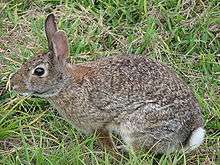 | |
| Eastern cottontail rabbit (Sylvilagus floridanus) eats grass, ferns, and leaves | |
| Scientific classification | |
| Kingdom: | Animalia |
| Phylum: | Chordata |
| Class: | Mammalia |
| Order: | Lagomorpha |
| Family: | Leporidae |
| Genus: | Sylvilagus Gray, 1867 |
| Type species | |
| Lepus sylvaticus | |
| Species | |
|
16 sp., see text | |
Cottontail rabbits are among the 20 lagomorph species in the genus Sylvilagus, found in the Americas.[1]
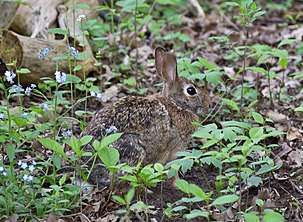
Most cottontail rabbits closely resemble the wild European rabbit (Oryctolagus cuniculus). Most Sylvilagus species have stub tails with white undersides that show when they retreat, giving them their name: "cottontails". This feature is not present in some cottontails (for example, the underside of the brush rabbit's tail is gray), nor is it unique to the genus (for example, the European rabbit also has a white scut).
The genus is widely distributed across North America, Central America, and northern and central South America, though most species are confined to particular regions. Most (though not all) species live in nests called forms, and all have altricial young. An adult female averages 3 litters per year, and can occur in any season; occurrence, and litter size depend on several factors including time of the year, weather, and location. The average litter size is 4, with some as low as 2, and as high as 8, though most do not survive to adulthood.
Cottontail rabbits show a greater resistance to myxomatosis than European rabbits.[2]
Evolution
The cottontail is one of several species of Sylvilagus; their closest relative is Brachylagus, the pygmy rabbit. They are more distantly related to the European and other rabbits, and more distantly still to the hares. The cladogram is from Kraatz et al., 2015, based on nuclear and mitochondrial gene analysis.[3]
| Leporidae |
| |||||||||||||||||||||||||||||||||||||||||||||||||||||||||||||||||||||
Lifespan
The lifespan of a cottontail averages about two years, depending on the location. Almost every living carnivorous creature larger or faster than the lagomorph is its predator. That includes: domestic dogs, cats, humans, snakes, coyotes, mountain lions, foxes, and if the cottontail is showing signs of illness, even squirrels.
The cottontail's biggest threat comes from birds of prey. Newborn cottontails are particularly vulnerable to these attacks. Cottontail lagomorphs use burrows vacated by other animals. Predators such as snakes are well aware of the areas used and reused by the cottontails, and kill the young at will. The mother is unable to defend her young. Though cottontails are sexually active, and mated pairs have several offspring many times in all seasons, few survive to adulthood. Those that do, grow very quickly and are full grown adults at three months.[4]
Eating mechanics
Unlike the squirrel and chipmunk that eat sitting up on their hind legs and can hold food with their front paws while spinning it in circles to devour it quickly, cottontails eat while on all fours. Cottontails can only use their nose to move and adjust the position of the food that it places directly in front of its front paws on the ground. The cottontail rabbit will turn the food with its nose to find the cleanest part of the vegetation (free of sand and inedible parts) to begin its meal. The only time a cottontail uses its front paws to enable eating is when vegetation is above its head on a living plant. The cottontail will lift its paw to bend the branch to bring the food within reach.[5]
Cottontails are rarely found out of their burrows looking for food on windy days, because the wind interferes with their hearing capabilities. Hearing an oncoming predator is their primary defense mechanism.[6]
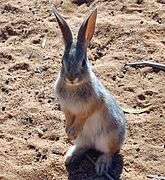 Juvenile cottontail standing in anticipation of food
Juvenile cottontail standing in anticipation of food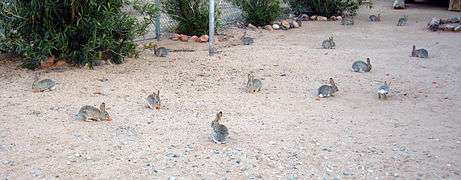 Cottontails are very sociable animals within their peer group
Cottontails are very sociable animals within their peer group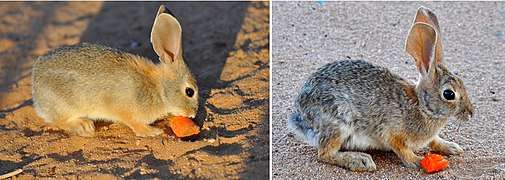 Male desert cottontail at 8 weeks, and the same cottontail at 16 months of age
Male desert cottontail at 8 weeks, and the same cottontail at 16 months of age
Species
Genus Sylvilagus
- Click on Species→ show to display all Species
| Species→ |
|---|
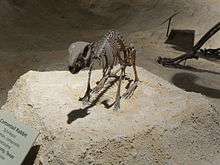 Pleistocene fossil The subgenera were described in the 19th century based on limited morphological data that have been shown to not be of great use, nor to depict phylogenetic relationships. Molecular studies (limited in scope to the mitochondrial 12S gene) have shown that the currently accepted subgeneric structure,[1] while of some heuristic value, is unlikely to withstand additional scrutiny [7]
|
References
- 1 2 3 Hoffman, R.S.; Smith, A.T. (2005). "Genus Sylvilagus". In Wilson, D.E.; Reeder, D.M. Mammal Species of the World: A Taxonomic and Geographic Reference (3rd ed.). Johns Hopkins University Press. pp. 207–211. ISBN 978-0-8018-8221-0. OCLC 62265494.
- ↑ Carter, G.R.; Wise, D.J. (2006). "Poxviridae". A Concise Review of Veterinary Virology. Retrieved 2006-06-13.
- ↑ Kraatz, Brian P.; et al. (2015). "Ecological correlates to cranial morphology in Leporids (Mammalia, Lagomorpha)". PeerJ. 3: e844. doi:10.7717/peerj.844. PMC 4369340. PMID 25802812.
- ↑ "Sylvilagus floridanus". Retrieved 28 June 2017.
- ↑ "Small mammals" (PDF).
- ↑ "Rabbits and Hares".
- ↑ Ruedas, L. A., S. M. Silva, J. H. French, R. N. Platt II, J. Salazar–Bravo, J. M. Mora, and C. W. Thompson. 2017. A prolegomenon to the systematics of South American cottontail rabbits (Mammalia, Lagomorpha, Leporidae: Sylvilagus): designation of a neotype for S. brasiliensis (Linnaeus, 1758), and restoration of S. andinus (Thomas, 1897) and S. tapetillus Thomas, 1913. Miscellaneous Publications of the Museum of Zoology, University of Michigan, No. 205. pp. i-iv, 1-67, 33 figs., 5 tables, 2 appendices, and supplementary material. (ISSN 0076-8405)